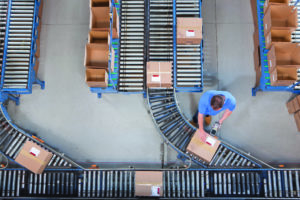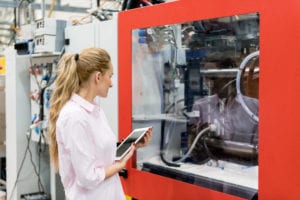Before the onset of the industrial revolution, products and resources were produced in a starkly different way. The workforce had a huge role in every step of the production process, from integrating the raw materials to designing.
However, the introduction of machines, devices, and equipment revolutionized how the industrial sector functions. The operators and administrators only managed and supervised the processes while machines performed all the integral functions. In the last couple of decades, the onset of digital and automation technology again shuffled the roles and responsibilities of the industrial workforce. This article will delve into the role of automation [1] in industries while focusing on the features and advantages of investing in an automatic conveyor system. However, first, let us understand the basic definition of automation.
Key features of automation technology
To put it simply, automation technology comprises all work and processes equipment that enables systems and plants to run independently without any human intervention. To elaborate further, we have mentioned some of the many features of automation technology:
- Process mapping
- Process Intelligence
- Document generation
- Automated workflows
- Robot Process Automation (RPA)
What is an automatic conveyor system?
One of the primary motives of every industry or business owner is to ensure that they offer top-class products, services, and solutions while making a considerable amount of profit. Therefore, most industry owners do not hesitate before investing in high-functioning automation devices and equipment that will fetch optimum results quickly.
An automatic conveyor system is one instrument that is deployed in almost every automated industry. In layperson terms, these systems are exclusively designed to transport products from one point to another seamlessly. Due to multiple grippers and infeed systems, it is easy to palletize any product, including fruits, vegetables, packaged products, meat, and more.
How do automatic conveyor systems work?
An automatic conveyor system uses advanced sensors, motors, and controllers to transport materials along a predefined path without the need for manual intervention. These systems can be precisely programmed for specific tasks, ensuring accurate and efficient material handling. Automatic conveyors enhance overall productivity by significantly reducing human error and labor costs. This makes them indispensable in the manufacturing, packaging, and distribution industries, where efficiency and reliability are paramount.
Types and examples of conveyor systems
Conveyor systems are available in various different types, including belt conveyors, roller conveyors, and chain conveyors. Examples include belt conveyors for transporting goods in warehouses, roller conveyors for assembly lines, and chain conveyors for heavy-duty industrial applications. Automatic conveyor systems can be seamlessly integrated into these various types to improve efficiency and automation in handling materials.
How do automatic conveyor systems benefit different industries?
Automatic conveyor systems provide valuable benefits to various industries. They enhance production efficiency, reduce labor costs, minimize errors, and ensure consistent product quality. Industries like manufacturing, logistics, food processing, and e-commerce rely on these systems to streamline operations, boost productivity, and maintain competitiveness in today’s fast-paced market.
Advantages and disadvantages of automatic conveyor systems
Automatic conveyor systems are highly suited for handling massive product volumes in different packaging formats. Here are some of the many advantages and benefits of leveraging an automatic conveyor system:
-
Minimal labor costs
The basic premise of automation technology is to perform all industrial functions with the assistance of intelligently designed equipment and devices. This automatically reduces the workload of the onsite operators since they only have to overlook all the ongoing processes and functions.
With the deployment of automated conveyor systems, the industry owner can get enough work done by investing in one system, which reduces cost and increases savings. On the other hand, one of the biggest drawbacks of onboarding equipment like automated conveyor systems is that it makes the job profile of the onsite workforce redundant.
However, one needs to keep in mind that automation technology functions independently around the clock. This gives an abundance of time to the workforce to take breaks and relax, which allows the workers to put their best foot forward at work, leading to high productivity and minimum errors.
-
Makes the warehouse more spacious
On a fundamental level, automation systems integrate multiple different technologies. Similarly, if the industry does not have an automatic conveyor system, the workers would have to manually go through every package to pile and sort the products.
This process is tedious and would also require a sufficient amount of safe space to place the goods in a streamlined manner. Automated conveyor systems are designed to resolve these problems by providing steady transportation and solutions efficiently. How is that?
Once the automatic conveyor system is in motion, the goods are sorted out to be sent to the next unit without any unnecessary storage space. In addition, one can consistently load and unload specific units when required; therefore, there is no need to stop all units at once.
-
Accelerates productivity and operational efficiency
One of the biggest challenges in the industrial sector [2] is transporting goods across the warehouse. It wastes employee efforts and time and leads to operational inefficiency with a major loss in productivity, making it difficult to achieve business goals. In contrast, automatic conveyor systems help meet efficiency goals by offering solutions that deliver goods to their allotted stations.
We have highlighted some automatic conveyor systems’ challenges or drawbacks to give you a complete purview of the equipment. This will help you make an informed decision before you purchase your industrial equipment:
- Reduced flexibility for change
- The initial cost of the instrument
- Repair and maintenance cost
- Downtime due to malfunction
Choosing the right conveyor system
Choosing the right conveyor system involves evaluating your specific needs, such as the type of materials to be transported, the required speed, and the environment. Consider factors like system capacity, durability, and compatibility with existing equipment. Assess the system’s maintenance requirements and energy efficiency.
Consulting with experts in automatic conveyor systems can provide tailored solutions that maximize efficiency and comply with safety standards. These solutions can fit your budget, ensuring optimal performance for your operational needs.
Leverage best-in-class automation solutions with Schneider Electric
At Schneider Electric, we have a team of futuristic minds driven to build a digital and automated future. Over the years, we have taken pride in helping thousands of customers to do more with fewer resources, successfully proving the immense power of digitization in industrial automation and energy management.
We leverage our applied experience with deep domain knowledge to deliver a diversified portfolio of digital solutions across multiple industries like data centers, commercial real estate, facility management, hotels, healthcare, process automation, and more.
Explore our website today to know more about our automation solutions, products, and services!



